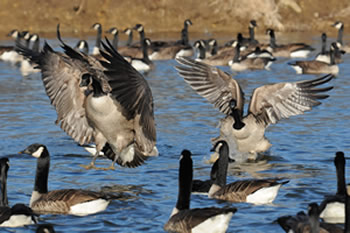 by Ted Nichols, Wildlife Biologist
by Ted Nichols, Wildlife Biologist
Waterfowl Ecology and Management Program
May 10, 2019
Background
Setting hunting regulations for a species with two or more populations, particularly populations which may have different population trajectories, can be very challenging. Canada geese are a prime example. Within New Jersey there are three distinct populations of Canada geese (Figure 1): Atlantic Population (AP), North Atlantic Population (NAP) and Resident Population (RP). AP Canada geese nest in boreal forest and tundra of northern Quebec with the densest populations along the Ungava Bay and Hudson Bay coasts. NAP geese nest further east in Newfoundland and Labrador.
Collectively, AP and NAP geese are commonly known as "migrant" geese since they breed in northern Canada and migrate to southern Canada and the U.S. to spend winter. AP geese winter throughout the mid-Atlantic and the Delmarva Peninsula. NAP geese have a much more coastal-oriented wintering area from Maritime Canada to New Jersey. RP geese breed in southern Canada and throughout the US and generally make no migration or relatively short migrations in winter. RP geese have readily adapted to man's environment and are generally the goose population responsible for damage complaints regarding droppings and poor water quality. All three populations of geese readily mix in fall and winter.
Geese from the different populations face very different circumstances in their life histories given the geographic location of their breeding areas. For AP and NAP geese, young production can vary dramatically from year to year, largely dependent on the timing of spring snowmelt as well as the frequency and duration of late spring (June) snowstorms. During years when snowmelt is late, young production of migrant geese is poor.
RP geese, on the other hand, consistently produce a large number of young since they breed in relatively stable mid-latitude climates. In addition, RP goslings face relatively few predators when compared to their sub-Arctic breeding cousins that routinely face Arctic fox, bears, and raptors. Survival rates of adult geese can be very different as well.
AP and NAP geese must face the rigors of migration both in fall and spring. In addition, sport hunting can have a significant impact on survival rates of long-lived birds such as Canada geese, and must be carefully regulated. AP and NAP geese can be subjected to significant hunting pressure as they pass through two countries and several states that may have hunting seasons with staggered dates. In addition, AP and NAP geese also must sustain considerable hunting pressure from indigenous, subsistence hunters in Canada when they return to breeding areas in the spring. RP geese, on the other hand, spend much of their time in parks, golf courses and corporate parks, where they are relatively inaccessible to hunters. These differences in young production and survival, are key components that drive the status of these three populations of Canada geese.
The following questions and answers will explain the management strategies behind current and new regulations:
1. How is Canada goose harvest managed within the Atlantic Flyway states?
When and where different populations of Canada geese are mixed, as is the case in New Jersey and other areas of the Atlantic Flyway during fall and winter, harvest regulations are crafted for the population which is most abundant in any given area. In the Atlantic Flyway, these zoning designations are based on patterns of leg band recoveries of geese from these four populations (Figure 2). In essence, most of New England is a NAP Zone, most of the central part of the flyway, including Vermont, eastern New York, New Jersey, eastern Pennsylvania, Delmarva, and eastern Virginia are the AP Zone, while the western and southern parts of the flyway is an RP Zone. Small portions of Pennsylvania and Virginia are designated as Southern James Bay Population zones.
The Atlantic Flyway Council has established criteria for portions of states to be designated as RP Zones; in essence, RP Zones have few migrant geese during fall and winter. In general, RP zones have the most liberal hunting seasons, typically 80 days with a 5-bird bag limit. Migrant population zones (NAP, AP and SJBP) zones typically have shorter seasons and smaller bag limits due to the presence of migrant geese.
2. Which parts of New Jersey are considered Atlantic Population Zones?
New Jersey's North and South Zones are AP Zones because a significant number of AP band recoveries occur there.
3. How are AP Canada goose seasons and bag limits determined?
The Atlantic Flyway Council and US Fish and Wildlife Service (USFWS) use a prescriptive harvest strategy to set season length and bag limits. The harvest strategy utilizes a 3-year average of the estimated number of breeding pairs of geese to determine the hunting season. After a period of population stability dating back to the early 2000s, the breeding population has declined for the past several years culminating in an 18-year low of 112,000 breeding pairs in 2018 (Figure 3).
Poor gosling production due to chronically late Arctic springs appears to be driving the recent population decline. Gosling production has been below average for seven of the past 10 years with 2018 being an unprecedentedly poor year (Figure 4). During most years, biologist crews in northern Quebec band nearly 3,000 goslings and see thousands more. In 2018, those crews banded only 30 goslings. Due to these poor status indicators, the "regular" Canada goose season will be reduced from a "moderate" hunting package to a "restrictive" hunting package.
|
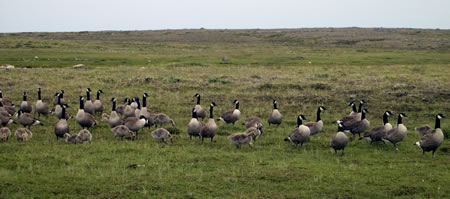
A flock of Atlantic Population Canada geese in Arctic Quebec about to be captured for banding
Click to enlarge
|
4. What does a restrictive hunt package mean for New Jersey's 2019-20 AP Canada goose hunting season?
A restrictive hunt package means that New Jersey can have a 30-day season with a 2-bird bag limit in the North and South Zones. The season can be divided into no more than two segments and must be held between November 15 and January 31. The Division and Fish and Game Council set 2019-20 season dates based on input from a committee of sportsmen from various organizations including the NJ State Federation of Sportsmens Clubs, NJ Waterfowlers Association, Ducks Unlimited, and Delta Waterfowl.
5. Why will a restrictive hunt package be implemented for the 2019-20 season?
While the 3-year breeding pair average (155,000) was slightly above the Harvest Plan threshold for a restrictive season (150,000), a strong downward trend in the number of breeding pairs coupled with extremely poor reproduction in summer 2018 caused Atlantic Flyway biologists to preemptively recommend a restrictive hunting season for 2019-20. While this below average reproduction is due to late spring thaws on the nesting grounds, a restrictive hunting season will help protect breeding adults that are key to population recovery.
6. How are other Atlantic Flyway states affected by the implementation of a restrictive hunt package for AP Canada geese?
All AP Zones of Atlantic Flyway states are affected. The harvest strategy identifies harvest packages for four regions: 1. New England (VT, CT, MA); 2. Mid-Atlantic (NY, PA, NJ); 3. Chesapeake (MD, DE, VA); and 4. North Carolina. Under the restrictive package, New England and Mid-Atlantic Regions will have a 30-day season with a daily bag limit of 2 birds. The Chesapeake region will have a 30-day season with a daily bag limit of 1 bird. North Carolina's season will remain unchanged as they generally implement a more restrictive season (15 days/1 bird).
The disparity in the bag limit between New England and Mid-Atlantic states and Chesapeake states is because a much higher proportion of AP geese versus RP geese are taken in Chesapeake states. Said another way, New England and Mid-Atlantic states winter fewer AP geese and consequently these states have less impact on the status of AP geese.
7. Which parts of New Jersey are considered North Atlantic Population Zones?
From 2015-18 New Jersey's Coastal Zone was designated as an experimental RP Zone and had an 80-day season with a 5-bird bag limit. After evaluation, it was determined that the Coastal Zone failed to meet the criteria for an RP Zone. However, since the Coastal Zone has relatively few band recoveries of AP Canada geese, it was re-designated as a North Atlantic Population (NAP) beginning in 2019. The NAP harvest strategy calls for a 60-day, 2-bird bag limit in areas including New Jersey so the 2019-20 Regular Canada goose season in the Coastal Zone will occur concurrent with the 60-day duck season.
8. Which parts of New Jersey are considered Resident Population Zones?
None. Note in Figure 2 that most RP Zones in the Atlantic Flyway occur in the west where there are few AP and NAP goose recoveries. Given New Jersey's small size, and north-south orientation, none of our state's areas qualify as RP Zones.
9. How will these changes affect the September and Special Winter Canada Goose Seasons?
These two seasons, where predominantly Resident Population Canada geese are harvested, will remain unchanged.
10. Why can't the Special Winter Canada Goose Season just be implemented statewide?
In the Atlantic Flyway, special winter seasons are held in areas of Massachusetts, Rhode Island, and New Jersey that do not meet RP Zone criteria but have relatively low populations of AP and NAP geese during late winter after Canada geese "settle out" after migration. Criteria established by the Atlantic Flyway Council and USFWS are that no more than 20% of the Special Winter Season harvest can be comprised of migrant population Canada geese.
The zones were established based on patterns of migrant goose leg band recoveries, neckband observations, and satellite telemetry data predominantly from the 1990s. Contemporary patterns of leg band recoveries of AP Canada geese suggest that there have not been major changes in the winter distribution of AP geese during winter within New Jersey. These data suggest that the selected winter zones in New Jersey barely meet the agreed 20% criteria. Excluded areas of the state, particularly southwestern and central New Jersey appear to greatly exceed the 20% migrant criteria.
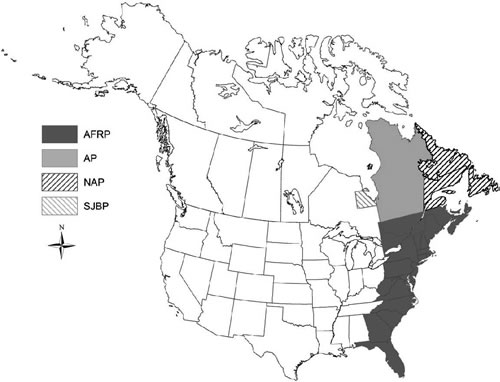
Figure 1. Geographic location of breeding populations of Canada geese in the Atlantic Flyway.
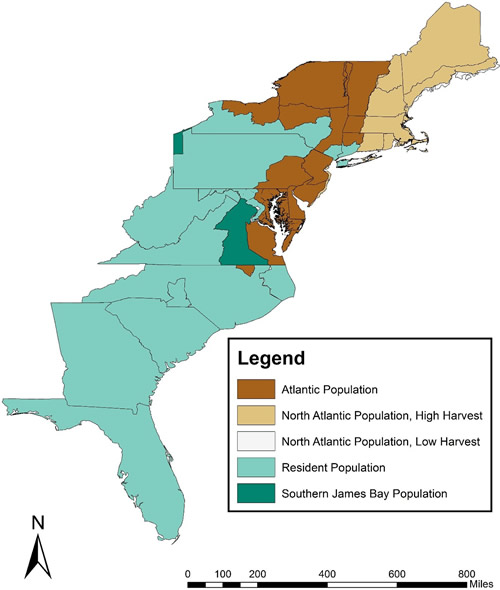
Figure 2. Canada goose harvest management zones in the Atlantic Flyway, 2019.
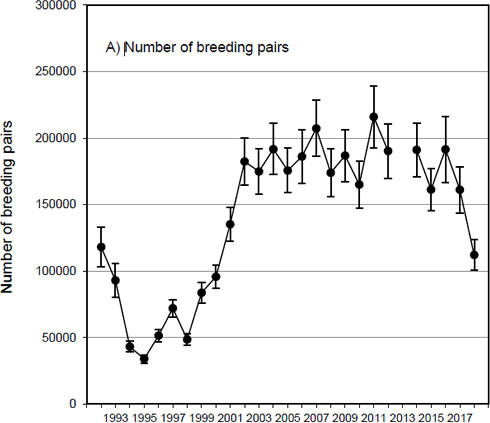
Figure 3. Estimated number of Atlantic Population Canada goose breeding pairs on the Ungava Peninsula, 1993-2018 (No survey was flown in 2013).
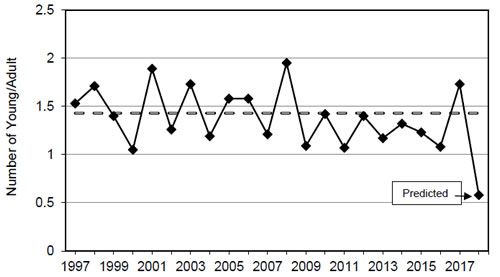
Figure 4. Actual number of goslings per adult captured in banding drives on Atlantic Population Canada goose breeding grounds, 1997-2017 and predicted age ratio for 2018. Dashed line is long-term average.

 by Ted Nichols, Wildlife Biologist
by Ted Nichols, Wildlife Biologist



